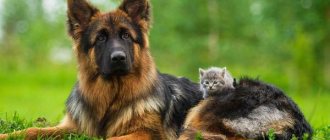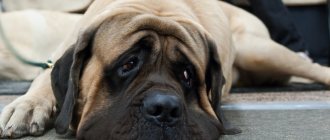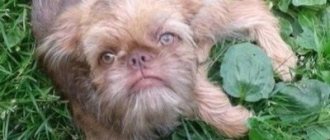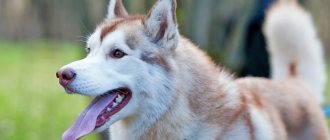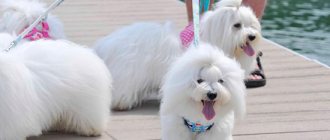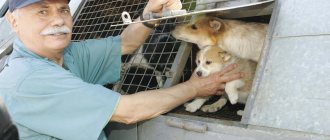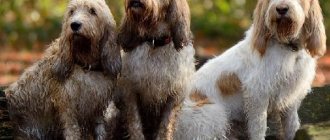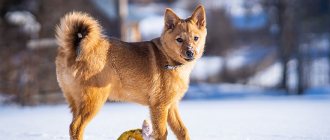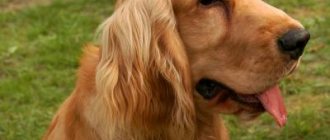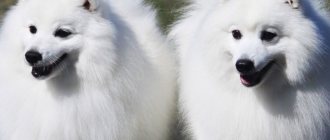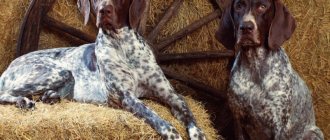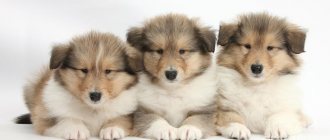History of the breed
The Japanese Laika is one of the most ancient breeds in the world. In their homeland, they are considered a national treasure and are protected by the specially created organization Nippo. The breed has been known since the 6th century and has retained several names: Matagi-ken (guard dog against large animals), Kazuno-inu, Odate-inu (from the names of the prefectures of origin).
The history of the breed begins in the Akita province in the northern part of the largest Japanese island of Honshu. The origin of the breed is closely associated with the city of Odate, as evidenced by the results of genetic studies of dog skeletons found in the area. The found remains of Spitz-type dogs date back to the 2nd millennium BC.
Ancient drawings have been preserved depicting the use of Akita Inu dogs for hunting purposes. The materials date back to the 4th-6th centuries AD.
Already in the sixth century, kennel clubs were organized in Japan, which created the first standards for Japanese indigenous breeds, instructions for care, maintenance and training. So-called stud books were created, where the names, dimensions, colors and parents of specific dogs were recorded.
In the 17th century, Akita Matagi dogs were used for dog fighting. Already in the 19th century, the breed acquired a more modern appearance: large dogs were needed in dog fights, breeders began crossing Akita with Tibetan mastiffs and Tosa Inu. In 1931, nine representatives of the breed were given the status of “Natural Monuments”. The further development of the breed was associated only with these representatives.
During World War II, all dog breeds were exterminated except German shepherds. The owners were forced to hide in the forests along with purebred representatives of the breed. After 1954, the breed was divided into 3 subtypes: hunting, fighting and crossed with the German Shepherd. Since that time, Akita Inu has become widespread throughout the world.
American Akita Inu
The history of the origin of this type of Akita Inu is sad. During World War II, Japanese Akita Inu were actively exterminated for the sake of wool, which was used for warm clothing, and only German shepherds were preserved, as they were considered the most capable for service.
Loving Japanese Akita Inu owners, of course, were looking for ways to save their pets and found one: crossing their dogs with German shepherds so that their puppies would pass for “Germans.” This is how one of the species of the breed came into being, or rather, its closest relative - the American Akita Inu. They began to call it American when it was transported to America, where it was warmly received and actively bred.
The American Akita Inu is much larger than its Japanese ancestor, so it has another name - the Great Japanese Dog. It differs in both appearance (a completely different color than the Japanese one) and character (it is much tougher and straighter). This is a very rare breed of dog and its price is high - from 50 to 100 thousand per puppy.
Full description of the breed
The updated FCI breed standard (04/02/2001) classifies Akita as an Asian Spitz and a primitive breed (group 5, section 5). The description of the breed in the document states that Akita is a dog with a strong and durable physique, balanced, and distinguished by a noble appearance. The weight of an adult dog is from 40 to 50 kg. Proportions of dimensions (height at the withers to length of the body): 10:11, in females the body dimensions are slightly longer than in males.
Classic sizes of an adult dog: height at the withers: 64-70 cm (male), 58-64 cm (female).
| Characteristics of the appearance of the breed | |
| Scull |
|
| Stop |
|
| Nose |
|
| Muzzle |
|
| Lips |
|
| Jaws/teeth |
|
| Eyes |
|
| Ears |
|
| Neck |
|
| Back |
|
| Breast |
|
| Stomach |
|
| Tail |
|
Read Full characteristics of the Alpine Cattle Dog, facts about the origin of the breed
Purebred representatives of Akita Inu have a coat consisting of three layers. The expressive appearance is emphasized by characteristic colors; four colors are allowed:
- Red-fawn (red);
- Sesame (dark brown);
- brindle;
- White.
In all variants except white, the characteristic Japanese Akita “urajiro” must be present.
Urazhiro - white coat color on the sides of the muzzle, cheekbones, lower jaw, neck, chest, body, tail and on the inner surfaces of the legs.
Any markings with a white color are a disqualifying sign. A black mask on the face is also considered a clear defect. Many consider long-haired Akitas to be a separate breed; according to the FCI standard, long hair is considered a disqualifying feature.
Black, gray and black and white colors are common on notice boards. These dogs are not purebreds, just like fluffy ones.
Varieties of Akita Inu
Today, Akita is divided into only two types: the Japanese Akita Inu and the American and Canadian Akita. After World War II, soldiers brought puppies of the breed to the USA and Canada. Local breeders began crossing Akitas with German Shepherds and Mastiffs. The result was a dog with a stronger and stockier build. At the same time, the American representatives of the breed retained their characteristic appearance features and color standard. The FCI classification does not recognize them as different breeds; only the American Kennel Club divides these dogs into 2 types.
Breed standard
The Akita Inu dog is a medium-sized dog. Bitches weigh up to 35 kg, and males - up to 45. A slight overweight is acceptable. The height at the withers of the former is up to 64 cm, and the latter – up to 71 cm. The animal has a strong and harmoniously built body. Straight back without bends. Strong muscles run along its length, but due to the dense fur they are not visible. The ribs on the sides are also not visible.
The sternum is well developed. It does not stick out, but is quite wide in volume. Strong elongated neck with slight dewlap. The transition to the head is weakly expressed. The tail is fluffy, long, rounded with a ring. According to the standard, it should lie on the lower back. The Akita has very powerful hind legs.
Thanks to the elastic, dry muscles that run along the thighs, the animal is able to push off strongly from the ground and quickly increase speed. The forelimbs, like the hind limbs, are set parallel. A special feature of this breed is its soft paw pads, like those of cats. The knuckles should stick out on them. The claws are dark.
The dog's skull is wide, the head is shaped like a triangle. Eye set is average. They should not stick out or be planted too deep. The color of the iris is brown or dark brown. The nose of a representative of the breed can only be black. But in light-colored individuals, slight pigmentation is allowed on this part of the head. The dog's ears are erect. They should be miniature and slightly rounded at the ends.
The skin does not fit very tightly to the body; in some areas, for example, on the neck, there may be folds. The coat is medium in length, very lush and thick. There is an undercoat that is delicate and soft to the touch. The standard allows for a lot of variations in the fur color of such a dog. It can be piebald, brown, sandy, pure white, reddish, etc.
If the individual is light-colored, then its front part of the body, or rather the chest and the tip of the muzzle, should be pigmented white. Important: the standard allows for differences in shades between the undercoat and the main coat. The Akita Inu in the photo looks interested and very smart. There is insight, foresight and intelligence in this dog's gaze. He undoubtedly deserves respect.
The most common colors of Akita Inu
Character, intelligence and temperament
The character of the Akita has its own characteristics, sometimes they are playful and restless, in other cases they are serious and aggressive. From a very early age and up to 2.5 years, dogs are very active, cheerful and easily make contact with people. After approximately two years of life, this behavior changes to calmness, equanimity, and isolation.
Adult Akita Inu is unemotional, but this does not mean that she does not experience any emotions - they carefully hide them.
This is a good companion dog for one owner. In case of danger for himself, the owner or his loved ones, aggression will not be long in coming. The genes of fighting dogs are partially transmitted to modern individuals. Dogs of this breed will not hesitate to protect loved ones or their territory.
The negative sides of the Akita Inu's temperament can be called great curiosity; they resort to any extraneous noise. On the other hand, these qualities are excellent for protecting property.
Training and education
Training should begin from the dog's early childhood. The Akita Inu is highly trainable, but the owner needs to be patient at the initial stage while the dog learns basic commands. It will be easier later. Disobedience cannot be a reason to use brute force against a dog. Akita is very vindictive and will not forget your aggression for a long time.
It is best to focus your training efforts on raising the Akita as a guard dog. Huge size and high intelligence are ideal for protecting a private home and owner from strangers.
Guard training classes are conducted exclusively by specially trained trainers. The training scheme is as follows: The owner holds the dog on a short leash, while the trainer waves a rag in front of the dog’s face. At this time, the owner gives the dog the “Stranger” command. Subsequent training is done with a simulation of an attack by the trainer on the owner.
The Japanese Shepherd performs well in hunting large animals. Hunting instincts have accompanied the breed for many millennia. Training for hunting will take relatively little time, and the owner will receive an ideal assistant. Akita Inu is best at hunting bear.
Home Security Guard
A country cottage guard is a street animal with the ability to enter the home. Alternatively, it is possible to place it in a spacious enclosure, equipped with a warm booth.
The selection factors in this situation are:
- thick coat, warm undercoat;
- obedience, hard work;
- ability to adequately assess threats;
- independence in decision making;
- distrust of strangers.
When using “field” (yard) security, it is important to take into account the most important aspect: a working dog cannot be kept on a chain. Tethering and enclosure restraint are temporary measures, a momentary solution to protect house guests, utility workers, and social persons from aggression.
Most guard breeds are life-loving: lack of freedom and lack of movement drives the toothy guards into depression, causing mental and health disorders. An unbalanced, unmotivated and angry large Akita Inu is a threat and a guaranteed source of problems.
Care and maintenance
Keeping the breed is not difficult; they take root well in a city apartment or country house. Moreover, dogs have enough fur to live outside even in winter. Pet stores offer many types of clothing for these dogs, but this is more a style element than a forced purchase.
Read Interesting about the Alaskan Klee Kai: amazing facts about the breed, real reviews
Bathing and grooming
Caring for the coat does not take much time. It is enough to comb it just once a week with a special glove or a regular comb. Molting lasts no more than three weeks, usually from 10 to 15 days. At this time, you need to comb your dog to remove dead fur almost every day. Akita Inu does not need a haircut, bathing is recommended 2-3 times a year, special dog shampoos are used for this.
Tooth and claw
You will need to brush your teeth at least once a week, otherwise your dog may develop a dog smell from his mouth. To do this, you will need to buy a special paste and a brush that fits on your finger. It is quite enough to trim claws 1, maximum 2 times a month.
Akita Inu colors: white
Akita Inu with a white coat look perfect and very noble. You can even refer to the requirements of the breed standard to understand that ideally there should be no spots or darkening on the animal’s coat. However, they meet. An Akita Inu will still be considered white, even if there is a clearly visible yellowish “patina” on the back, withers or sides. However, for exhibitions this will be considered a disadvantage and a manifestation of the “uncleanness” of the breed.
Meanwhile, white Akita Inus are not albino. This is evidenced by black eyes, eyeliner and lips. The nose can be black, liver or even white.
The rarest and most valuable are Akita Inus, whose white fur coat shimmers with blue hues in the light.
This color is considered the youngest, as it was developed only at the beginning of the 20th century. It is extremely popular in Japan - more than in any other country in the world.
Caring for such a dog is difficult. It is believed that it is more susceptible to allergies than other colors (manifested by the appearance of spots on the coat). Therefore, you need to feed her only with special food.
What to feed Akita Inu
Dogs will happily eat dry food, but feeding it constantly is not good for them. In Japanese dog breeding circles there is a special menu for such dogs, although modern representatives do not go so overboard with food. The best foods for a balanced diet:
- Premium or super-premium dry dog food;
- Lean meat;
- Oatmeal, barley, rice porridge;
- Dairy products;
Veterinarians do not recommend giving Akito Uno wheat and oatmeal, corn, full-fat milk, fatty meats, and sausage is strictly prohibited. They are prone to obesity, so the amount of food consumed needs to be controlled. Clean, fresh water should be available.
Health and life expectancy
A strong physique and good health - this is about the Akita Inu representatives. Dogs get sick extremely rarely, but veterinarians point out common diseases for them:
- Joint dysplasia (hereditary);
- Gastric volvulus (acquired);
- Eversion of the eyelid (hereditary);
- Diseases of the thyroid gland (acquired);
The average life expectancy is 12-14 years. Diseases should only be treated by reputable veterinarians in your city. Dog owners often complain about allergies in Akita Inu; for treatment, an enzyme immunoassay must be performed. At the same time, the dog itches a lot and bites the irritated areas.
The causes of loss of pigmentation can be uveodermatological syndrome, skin infections and even allergic reactions to irritants.
On the other hand, an allergy occurs much more often in a person to Akita than vice versa. Before purchasing a puppy, it is advisable to test family members for allergic reactions. A healthy female of the breed gives birth to two to seven puppies.
Diseases and breed defects
The Akita Inu is considered a very healthy and hardy dog breed, so systemic diseases are extremely rare. Despite this, these dogs are predisposed to the following diseases:
- Intestinal volvulus or bloating, which is associated with improper feeding of the animal.
- Hip dysplasia.
- Eversion of the eyelid is considered a hereditary disease.
- Von Willebrand disease is associated with blood problems.
- Various eye diseases such as cataracts, glaucoma and retinal atrophy.
Timely contact with specialists allows you to solve a number of problems, both medically and surgically.
Two words about the legendary Hachiko
The story of the dog Hachiko shook all of Japan back in 1932. In honor of the heartbreaking story, a real monument was erected to the dog at the scene of the events.
A dog named Hachiko met his owner every day from work near the train station. But one day the man did not return from work - the owner of his faithful Akita died at work. Over the next 9 years, Hachiko came to the meeting place with the owner every day at the same time and waited for him.
The story gained such resonance that after the death of the dog, mourning was declared in Japan. Today, the Hachiko monument is a symbol of selfless love and fidelity. This story became known to the whole world after the release of the film “Hachiko: The Most Faithful Friend” in 2009.
How to choose an Akita Inu puppy
The choice of a puppy must be approached with all responsibility. In order to choose a good dog and a faithful friend, you need to adhere to certain recommendations:
- Buy only from reputable breeders;
- Check all the documents for the dog that the seller provides;
- If possible, meet the puppy's parents;
And the most important thing: the decision to own an Akita should not be hasty; weigh the pros and cons.
Read What is the difference between Akita Inu and Shiba Inu: comparison of breeds
Price
The price of puppies can vary greatly, it all depends on the achievements of their parents and class. PET class puppies (with non-compliance with the standard) will cost approximately $600 (40,000 in rubles). In Russia, the average price for a puppy of this breed on the market is 50,000 - 90,000 rubles. At the same time, there are offers that are much more expensive; the cost of representatives of the SHOW class reaches 250,000 rubles.
List of nurseries
The names of kennels in Moscow, St. Petersburg, Kiev and Minsk where you can buy good puppies: “From the City of Light”, “Ookami”, “Izumi Gai”, “LavrDeDis”, “Indigo-Smile”, “Lekdeiri”, “Skarb Palessya”. It is possible that in other cities there are lesser-known nurseries where good puppies are bred; write about them in the comments.
Akita Inu care
Although Akita Inu are very different from the breeds we are used to, they do not have many specific subtleties in care. We found out everything!
Conditions of detention
Akita Inu can live in an ordinary apartment and will grow up to be a real city dweller. They also really like being in nature, but you can’t leave the dog outside on a leash - it needs a home.
Hygiene
To keep the Akita's coat beautiful and neat, it should not be bathed often - a maximum of 2 times a year. And we need special hypoallergenic shampoos and products. But you will have to comb the beauty every day, with two brushes - for the coat and the undercoat.
Teeth are brushed every few days, and nails are trimmed every 2 weeks. You also need to examine your eyes and ears for abnormalities. Accustom your Akita to cosmetic procedures from childhood - and she will endure them patiently.
Walks
In order for an Akita Inu to grow up healthy and happy, it needs to spend at least two hours a day outside. They love different places, outdoor games and physical activity, and also choose their own routes and walk without a harness. Please note that you cannot walk your Akita immediately after eating, so it is better to feed the dog after the walk.
Education and training
Akitas are very smart, but also very stubborn, making them difficult to train. This is not a dog that will fetch a ball or slippers every time. She demands respect for herself, and only then gives it in return. Be patient, persistent and persistent!
Photo review
Owner reviews
My story of meeting my Sam began more than a year ago.
Today I’m happy with everything, I couldn’t find a better friend, I’m not afraid to walk along dark alleys with him and I’m not afraid to leave him alone in the apartment. He likes to go for walks a lot, although he doesn’t ask for them. The only thing is shedding. For two weeks the entire apartment was covered in wool. I have to run after him with a vacuum cleaner :) Natasha, Moscow
Akita became my first dog. Male. After cats.. The most loyal, wise, obedient, super-duper DOG in the world! he needs to devote a sufficient amount of time, I have it. After work you should always go for a walk. And the dog is happy and you are ready for bed. IMHO!
Surprisingly, my dog tolerates car trips well, although what am I talking about... some say that he behaves calmly for 2-3 hours on an airplane. Now I always take it with me when I go somewhere on personal business. I think he likes it, you can see from his face that he’s happy. Once she saw herself in the side mirror, she admired herself so much! I advise potential owners not to worry, they are kind dogs and, most importantly, wise - so you will definitely find a common language! Try it.
Negative reviews from hosts
My dog absolutely does not tolerate riding in a car. Literally a couple of kilometers and she immediately vomits. As a puppy, we took her 550 km from home; everyone remembered this trip for a long time. At first she vomited everything that was in her stomach and calmed down a little. The road is long, the dog needed to eat. Everything I ate came out immediately; I can’t tell you the aroma in the car. It was the same at home. With my now adult dog, I can’t drive a car, even around the city.
In 70% of cases, ours pees anywhere, sometimes she even pees while walking. If guests come to us - surprise, Nomi pees in joy where she stands. Of course, we punish her, but we are afraid that it might be some kind of disease of the genitourinary system. We bought a diaper so that at least at night she wouldn’t pee under herself.
We got our Akita just 2 months ago. I understand that it’s hard to demand anything from a two-month-old puppy. But he doesn’t allow anyone to pass through the apartment and constantly bites everyone’s legs. Curses addressed to the puppy are taken offensively, but he continues to grab his legs as if nothing had happened.
